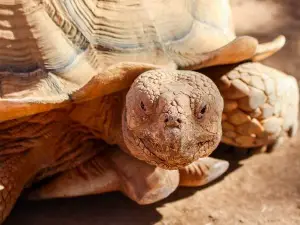
Turtles generally come in earth-tone colors, they are green, brown, and black and few people associate turtles with an orange coloring, but this may be happening with your pet and you may be concerned.
This article is a look into why your pet turtle is orange
Table of Contents
Why is my turtle orange?
Understanding why your pet turtle looks a certain way, or does certain things, will help you understand the animal overall, and one thing that you may not understand is why the turtle is orange
Here is why your pet turtle is orange:
The species:
Certain species of turtles have very interesting and unique colorings on their bodies. An example of this is the colorings on eastern box turtles. These animals have dark brown shells with yellow-orange markings
These brightly colored markings are what distinguish these types of turtles from other types of box turtles.
Eastern box turtles need this coloring on their shells to camouflage themselves among the damp earth, debris, and fallen leaves in forests that they usually live in.
So what you’re seeing may be the normal coloring of these turtles.
What to do:
This coloring is normal for these types of turtles, you don’t have to worry about your pet if this is the species of turtle that you have
Diet:
If your pet is eating a lot of a certain food, like shrimp or food that is rich in beta-carotene, then this can cause the animal’s shell to take on a more orange-red color, this may be what you’re seeing in your pet.
This coloring will more so be seen in the zones of new growth on the animal’s scutes.
What to do:
Take a break from feeding your pet shrimp and foods rich in beta-carotene. Do this for some time and see how the animal’s body reacts and if the orange coloring goes away.
Matching substrate:
Another reason why your turtle may be changing to orange may be that it is trying to match the background substrate.
Research shows that these animals can mildly change their shell color and they do this to minimize being seen by predators in the area.
While this change isn’t as drastic as how a chameleon changes its color, it is something that will catch your eye.
What to do:
You don’t have to worry if you see your pet doing it, this is normal behavior.
As long as the animal isn’t showing signs of being ill or in distress because of the color change then your pet should be fine.
Illness:
Another reason why your pet may start to develop orange areas on its body is that the animal is sick.
The animal may have sustained a would and this wound may have become infected causing your pet to look orange or red
What to do:
Taking your pet to the vet if you think that it’s suffering from some sort of sickness is recommended.
The vet will physically examine the turtle and do bloodwork to figure out what is going on.
Doing a water analysis to check the ammonia levels, pH, and hardness of the water is also recommended. This can usually be done by local businesses or by pet stores.
If you enjoyed this article then you may also be interested in other turtle/tortoise related articles. Here are some articles that you may be interested in: Why Is My Turtle Extending Its Neck?, Why Is My Turtle Sticking His Neck Out?, Why Is My Turtle Lazy?, Why Is My Turtle Leaning To One Side?, Why Is My Turtle Scratching His Neck?, Why Is My Turtle’s Neck Peeling, Why Is My Turtle’s Neck Red?, Why Is My Turtle On Its Back?, Why Is My Turtle Neck Swollen?

